
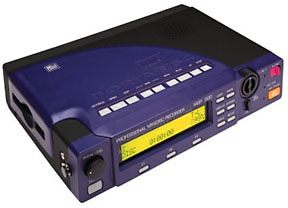
Hardware Product Review - Professional Mini-Disc Recorder July 17, 2001
Professional Mini-Disc Recorder Review
HHB MDP- 500 - M.S.R.P. $1,495.00 Street Price $1,299.99
HHB Communications USA Inc.
1410 Centinela Avenue, Los Angeles, Ca. 90025-2501
http://www.hhbusa.comReview by Dan Brockett
Preface - Great Pictures, Bad Audio
With apologies to Charles Dickens, for DV users, 2001 is the best of times, it is the worst of times. It is the best of times because of the unprecedented technological and communications revolution occurring. Because of this revolution, we have access to amazing camcorder technology for reasonable prices. Between tools like the Canon XL-1 and the Sony PD-150, we have access to relatively low priced, consumer/prosumer camcorders that offer formerly pro-only features like time-code, manual controls, zebra indicators, XLR inputs, switchable lenses and many other tools necessary to shoot professional video. The CCD chips and picture processing circuits and therefore, the resulting quality of the images that these camcorders can record has been improving by leaps and bounds with each new generation of consumer/prosumer DV camcorders introduced to the market. So what does this have to do with the HHB MDP-500 Mini Disc Recorder? Bear with me and I'll explain.
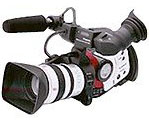
Canon XL-1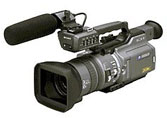
Sony PD-150Conspiracy Theory?
It is the worst times, though, in the sense that in their race to "out-feature" and outsell each other, the major camcorders manufacturers seem to have (how can I put this diplomatically?) "overlooked" the basic necessity of high quality audio acquisition to any video or digital filmmaking project. It may sound a bit cynical, but think about it. If you were a marketing executive for a large, anonymous, multi-national video conglomerate, how would you keep selling your comparatively expensive $10,000.00 to $20,000.00 DV format professional camcorders, if, along with picture quality almost equal to the "big boys", the audio quality was also perfect on your $3,800.00 prosumer camcorder? Hmm, makes one think about the mixed signals the company would be sending to the market if their consumer DV camcorders were, overall, "too good"?

Based upon my experience with the two camcorders mentioned in the first paragraph, plus several other of the most popular units including the Canon GL-1, Sony TRV-900, Sony PD-100, Sony VX-2000, most of the available three chip consumer/prosumer DV based camcorders seem to offer large compromises in the area of audio acquisition. As in the rest of video and film production in general, audio has seems to have been delegated the role of "neglected stepchild" in the design and execution of these units. I am only putting forward some conjecture as to the reason that this state of affairs exists and I could obviously be wrong, but the bottom line is that the audio quality on many of the newer, second generation DV camcorders is worse than the first generation product that they replaced. This is a shame, because as any successful video or filmmaker knows, audio is just as important as picture in creating effective, involving, exciting storytelling. I may be somewhat biased in owning a sound design company, but to me, a video or film's soundtrack is even more important than the picture as far as emotionally involving your audience in your story. You can watch so-so lighting and camera movement with a good soundtrack but just try to watch good lighting and camera work with a bad soundtrack. Yes, I know that describes MTV. Well, you get my point.
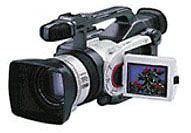
Canon GL-1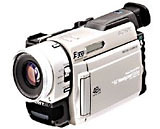
Sony TRV-900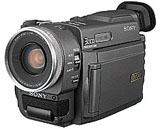
Sony PD-100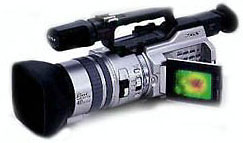
Sony VX-2000It's a Hack But It Works
Out of frustration with the lack of sound quality and audio features that most of the newer three chip DV camcorders are missing, a few serious DV users have began to experiment with using DAT recorders, DAT Walkman, consumer MD recorders, and as of late, portable Walkman-style hard disc recorders to record double system sound while shooting video. This is a procedure where sound output from the shoot's normal microphones and mixer are routed not only to the camcorder but also to an external recorder. While somewhat common on high-end, multi-camera video shoots, up until about a year and half ago, I had never heard of anyone doing this with consumer/prosumer level equipment and DV camcorders. With professional video and audio gear, SMPTE time code capability is fairly common, so recording your audio track split out to the camcorders for reference and to a time code DAT or DA-88 for later syncing in post was really no big deal. As you probably know, none of the consumer/prosumer DV camcorders offer time code input and output connections or video sync or genlock input or output connections. Obviously, none of the DAT Walkman or consumer MD recorders offer time code support or genlock either. However, DV camcorders have as fairly precise internal digital master clock as do even consumer DAT Walkman and MD recorders.
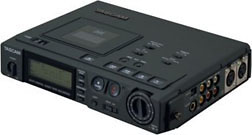
DAT recorder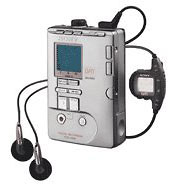
DAT Walkman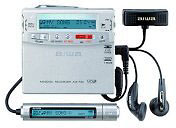
Consumer MD recorders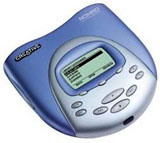
Walkman-style hard disc recordersUsers learned that with the advent of high-quality DV non-linear editing systems, it wasn't really that difficult to put a clip up on a video timeline in a video editing program, put up a sound clip from the DAT or MD recorder, turn on the audio waveforms and using waveform matching and listening to the delay between the two signals and line the two audio signals up. Sure, eventually the two sources would fall out of sync but for typical video shooting styles with relatively short takes, the two sources seemed to stay within a frame's accuracy of each other long enough to be useful with narrative material, if not for long takes in event and documentary projects. This is a way to bypass the bad audio quality that most of the consumer/prosumer DV camcorders seem to have. Also, there are several other benefits to shooting double system sound as well as several drawbacks that we will address later. DV camcorders, DAT Walkman and MD recorders were never intended to work together, but because of the resourcefulness and basically, the inventive spirit of DV users, this has become an accepted way of working. It shouldn't work. But it does.
Alright, Get On With It Already!
The HHB MDP-500 is a fairly unique piece of equipment that was mainly conceived by HHB as a tool for the professional radio journalist. Based on my understanding of the MD format from several years ago when it first hit the market, it seems that the format was originally conceived as a way for people to record Grateful Dead, Phish and Dave Matthews Band concert bootlegs, make their own music compilations from CD's and later, MP3s. The MD format was the electronics manufacturers way of addressing the audio cassette copying controversy of the 70's and 80's, brought up to speed for the digital age. Most consumer MD recorders only feature a digital input and not a digital output. Many of the consumer MD recorders have no recording level adjustments or recording levels that can only be adjusted while in pause. All of this makes consumer MD recorders not very well suited for our purposes, recording sound for picture. With no simple, easy method for interfacing with professional microphones and audio mixers, limited or no recording level adjustment and metering, flimsy consumer 3.5 mm input and output connections and shall we say, "delicate" construction, the consumer MD recorder doesn't seem to be the ideal candidate for a film or video set. The fact that some DV productions are using them successfully for this function is a testament to the determined low-budget film and video maker's resourcefulness. This is where the HHB MDP-500 enters the picture. We wanted to try out HHB's new, professional MD recorder under actual shooting conditions. Unlike consumer MD recorders, the HHB MDP-500 features some very unique and professional features that include:

- Balanced XLR Mic/Line inputs with 48V phantom power
- Coaxial and optical digital input and output
- Illuminated, 18 segment digital VU meters
- Limiter, ganged limiter and bass roll-off controls
- Clutched recording level control with a lockout mechanism
- USB connections for easy integration with all USB audio compliant Macs and PCs for real-time digital audio transfer to and from popular audio editing programs
- 40 second memory buffer
- Parallel remote capability
- 6 second pre-record buffer
- Intuitive menu system with 5 user setups
- On-board editing
- Included NIMH battery system with an extra caddy and charger included
- Internal loudspeaker
- Internal microphone
- Production soft case included
Who In The Heck Is HHB?
Our sound design company has been using two consumer Sony MD recorders for recording ambient sounds and occasionally for recording double system sound when shooting certain projects with our hiss-filled Sony TRV-900 DV camcorders. The thought of auditioning a professional, portable MD recorder from a company with the reputation that HHB enjoys amongst sound professionals was too good to pass up. For those readers not in the professional sound business, a little background is in order. HHB http://www.hhbusa.com is the U.K. based manufacturer of the HHB Portadat line of professional portable DAT recorders as well as some really nice CD burners and audio monitors. Although recently discontinued, the HHB Portadat units have become somewhat of an industry standard amongst many professional sound mixers in feature films and television. The HHB Portadats also gained a good reputation for ruggedness and reliability because of their use by the BBC and CBC Radio for field reporting. Our previous experience with the HHB Portadat line has been stellar and I have always been impressed with their elegant design, excellent sound quality and functionality while in the field, recording under the stressful conditions of television and feature film.
The LayoutThe transport buttons on the top surface of the machine are laid out in a typical manner with a key-hold button to lock the current transport function. There are also buttons here to eject the disc (although it's labeled open, it really just pops the MD out of the loading slot) and to access the various edit functions. Logical interlock helps to prevent operator errors Ð the disc cannot be ejected or the power turned off while recording, for example. The bulk of operational controls are to be found on the front panel, with a large thumb-slide switch to enter record on the right hand side above a well-positioned pause button and a clutched rotary input level control (with mechanical lock). Three more buttons under the LCD serve as soft-keys to select options displayed on-screen when the various menus are active. The normal display mode shows the, level bar graphs, track number and duration, transport mode and battery capacity, with other selectable options including total and remaining times, clock and date, and disc name. Gathered around the clear LCD panel, there are a group of six buttons that control functions such as the LCD back light (momentary or locked), the Display configuration, setting track IDs, and accessing the various system setup and input selection modes.
A small DIN remote control connector on the right hand side panel accesses all transport functions through a simple parallel switch arrangement although we didn't wire up a remote control to test this function. The LCD also presents menu information when configuring the machine or editing recorded material. These menus are fairly simple and only present three options at a time, determined and selected by the soft keys. Navigating the menus is intuitive and logical. On the left hand side the headphone level control is normally recessed to avoid blasting the headphone output level accidentally if the control is hit. The control pops out when needed. The setup button on the front panel displays one of eight presets. The user can then cycle through to find and recall the desired one, reconfiguring the entire machine. Factory defaults provide for basic mic, line or digital recording configurations, whereas the user-memories (labeled User 1-5) may be set up to store various desired combinations of options from the Input and System menus. The MDP500 is equipped with Serial Copyright Management System (SCMS) permanently configured to allow only first-generation copies to be made via the digital interface ('Copy Once'). This specification is part of the MD format. For typical sound for picture usage, SCMS shouldn't be an issue.
What is ATRAC?
When the MD format was introduced several years ago, I auditioned the format and was not impressed with the sound quality. MD uses a data reduction scheme called "ATRAC", which stands for "Adaptive Transform Acoustic Coding." This is a data-reduction algorithm that is a little like MPEG 2. ATRAC has improved considerably since its introduction and the MDP-500 uses the latest V4.5 algorithm. ATRAC seems to work quite well, especially for the typically limited dynamic range of dialogue and ambient sound. While MD does not sound as good as DAT, it is much better than analog cassette.
How To Test It?
We received an MDP-500 MD package from HHB as we were planning several video projects. After discussion with our sound mixer, Randy Bickler, we decided that an upcoming multi-camera project would be a great testing situation for the MDP-500. I have read several other industry reviews on the MDP-500, but all of them were pretty much aimed at pure audio recording and radio journalism use of the MDP-500, but nobody had reviewed the unit for sound for picture use. We decided to test out the MDP-500 on a week long, multi-camera production to record double system sound. If the HHB was up to the task, we could use the MD sound in the final, edited production. If not, then we would still be sending mixer output to two Sony DSR-500WS camcorders, so we were covered either way.
The Warmup
I was due to leave town for some R&R the week before our large production was to begin so I decided to bring the MDP-500 with me on the trip so that I could become familiar with it's controls, layout and functions before subjecting it to the stress of our multi-camera shoot the following week. The HHB manual was well written and although HHB is U.K.-based, the owner's manual didn't present too much British specific terminology that can sometimes be confusing for us here in "the Colonies." As I read through the manual, I picked up a few more interesting features that weren't apparent in looking at the unit. For instance, the MDP-500 features a built-in sample rate converter, so digital signals between 32KHz and 48KHz that are fed to the MDP-500 are internally converted to MD's standard 44.1 KHz sample rate. I also discovered that the MDP-500 features some really handy features like an internal mic for slating takes, that the MDP-500 can record up to 80 minutes per disc in stereo or 160 minutes in mono, and that the unit also features a built-in speaker which can be really convenient for checking recordings in the field. The bottom line is that with it's built-in features, limiter, ganged limiter, bass roll-off, high-pass filter and AGC, it is conceivable to just use the MDP-500 for sound for picture alone without a field mixer, provided one doesn't need to record more than two channels of input at once. This is a fairly revolutionary concept and could be significant in the decision on whether to spend the $1,300.00 on the HHB versus buying a high-end consumer MD recorder and a decent field mixer. Figure $300.00 to $500.00 for a high-end consumer MD recorder and $800.00 for a typical two-channel professional field mixer and the MDP-500s price doesn't seem so expensive.
The Shoots
The following week, we embarked upon our week of shooting the multi-camera production using the MDP-500 to record double system sound. We were shooting a variety of sequences, ranging from a procedural training setup in a medical clinic to a roundtable discussion as well as a spokesperson doing "walk and talks". In all of the setups, a stationary DSR-500WS on a tripod would serve as the "A" camera and another DSR-500WS on a Steadicam would serve as the "B" camera. We didn't want to run an audio output cable from our audio mixer to the "B" camera mounted on the Steadicam since some fairly radical moves were scheduled for the camera and we didn't want to risk losing shots with audio cables snagging on anything. We really don't trust a wireless mic to transmit sound from the field mixer to the Steadicam mounted camera because of wireless mic's typical "hits", buzzes and hum.We decided to jam-sync the "B" camera to the "A" camera and shoot a time code slate for each take, and in addition to recording the audio mixers output to the "A" camera, we also recorded the audio "wild" with the MDP-500 ("wild" in this situation would mean that the MDP-500 is recording on it's own, without being jam-synced with time code to either camera or the time code slate since MD does not support time code). In operation, using the MDP-500 was very simple and straightforward. We set the MDP-500 to record a new index mark each time the cameras rolled, then logged the index marks on notes and sound reports. Because of the massive amount of takes an footage we knew we would end up with, we decided to video edit the project using the sync sound from the "A" camera first, then once we had client and agency approval of the rough cut we would add the MDP-500's audio during the audio sweetening phase of the project. Even if you are shooting with a camcorder with audio problems and or hiss as mentioned in the beginning of this review, I still recommend recording reference tracks on your camcorder so that you can put together your rough cut of your project without having to go through the time consuming operation of manually placing and syncing your MD audio or all of your footage. Once your rough cut is locked and you are going to do you final edit, then you can add the MD audio on just the takes that were used in the final edit. This is a much more efficient way of working with audio that has been recorded using an external audio recorder.
Post Production
After the shoots were over, we listened to the MD audio that we had recorded during the week. The audio sounded great. Based upon my experience with various camcorders DV format camcorders, the audio from the Sony DSR-500WS is actually quite good, so honestly, upon initial listening, the MDP-500 recorded audio on it's own didn't sound significantly better. But, if this project had shot on camcorders that have "substandard" audio (for instance, a TRV-900 or VX-2000), then the audio we heard from the MDP-500 would have been leaps and bounds better. This was a controlled experiment though and after A/B comparisons between the DSR-500WS audio and the audio recorded on the MDP-500, we were consistently able to pick out the MDP-500 recorded audio as sounding slightly cleaner and smoother than the DSR-500WS DVCAM audio. We recorded boom to L or channel one and lavaliere on R or channel 2 audio. The channel separation was good and we heard no bleed through of the boom channel to the lavaliere channel or vice-versa. One additional benefit of using MD that shouldn't be overlooked is that the media is very inexpensive. A typical professional DAT tape costs $10.00 to $15.00. With some careful shopping, we were able to purchase 74-minute MD media for as little as $2.00 each. On a long shoot, doing a lot of takes of each scene, the costs of DAT media can become significant and the savings using MD can also make a difference in saving money that can be put to better use somewhere else in the production.
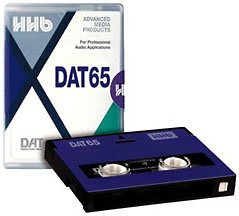
DAT tape costs $10.00 to $15.00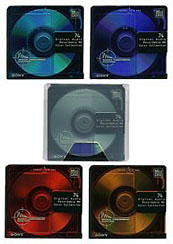
74-minute MD media $2.00 eachTrying Out All Of The Options
The week after our video shoot, we did have a chance to actually take a breather and try out some of the options that the MDP-500 offers that we weren't able to try during our shoot.
- A USB interface designed to interface the MDP-500 with both Macs and PCs. According to HHB, "The MDP's USB interface is for real-time audio transfers. Standard drivers included in Windows 98SE/2000/Me and Macintosh OS 9 and above recognize the MDP as a 'USB Audio Device'. This protocol allows for real-time streaming audio to and from the Portadisc." This feature alone is worth hundreds of dollars because it easily allows you to do a digital file transfer without having to buy any extra audio card or box. Very cool.
- The internal speaker, while not exactly hi-fidelity, did sound good enough to judge recordings while in the field. Ditto for the slate mic. In an extreme emergency, you could use this mic if your real mic went down and a spare was not available. Once again, not the best quality, but as a slate mic and backup, very handy to have if you ever need it.

- The included NIMH (Nickel Metal Hydride Ð none memory) batteries actually lasted their rated three hour run/record time. The unit also comes with a second empty battery clip that can be filled with regular AA NiCads for a shorter record time or more NIMH batteries that you could purchase separately. The extra clip is handy for long live event recordings since you can change the battery clips in about five seconds with practice when your first set runs out.
- The menu and user system is logical and easy to navigate. The amount of settings and parameters you can change are amazing. You can set a time and date stamp in the table of contents on all your recordings. Very handy. The menu system is also where you tell the MDP-500 which input(s) you will be recording to. We did not have a chance to test the coaxial or optical I/O, but most consumer and professional audio devices can interface with one or the other protocol.
- The 6-second memory buffer feature is almost like a magic trick but a very cool and useful one. Using this features allows the MDP-500 to continuously record a 6-second "buffer" so that if you are trying to record an event and you are not sure exactly when the event will occur, you will not cut off the beginning few seconds while you press record and get the unit up to speed. Think about how great this would be for recording a live event over which you have no control over when the event is to begin. With this feature, you can make sure that you are recording no matter when it starts without wasting a lot of space on your media. I can't wait until camcorders can do this too! Actually, Ikegami makes a broadcast hard disc recorder news camera called the "EditCam" that can do this. For about $50,000.00. It's pretty nice that this feature is here on this unit at its price range.
- Just like your CD Walkman that you go jogging with, the MDP-500 has a 40 second memory buffer which in the real world means, no skips, even when the unit is knocked or jostled.
A Slight Glitch?
During our week of shooting, our sound mixer, Randy did experience the MDP-500 "locking up" once. What I mean by "locking up" is that the MDP-500 would be in the middle of recording a scene and suddenly, the display, VU meter, counter, everything would just freeze. The unit would stop responding to any commands, including powering down. The only way to get the MDP-500 to respond was to remove the battery cover from the back of the unit, remove one battery for a second, reinsert it, then power the unit back up. Upon listening to the recording that was being laid back to the MD when this occurred, we did notice that the unit did keep on recording even though it was non-responsive to any input commands so we only lost about 10 seconds of actual recording. Fortunately, this was during a time right after a take so we didn't lose any of our scene's MD recording. But we could have had the glitch occurred just seconds earlier. This did only happen once during our week of shooting so we had just kind of written it off as a temporary glitch or "hiccup". The unit we were testing with was a review unit that had obviously been used by several other reviewers for undetermined amounts of time in undetermined ways. In short, we made note of it, then moved on. The unit worked flawlessly for the remainder of the shoot.The following week, I was doing some further testing of the unit with recording location sound effects. The unit, which had performed perfectly for quite a few days after the first glitch the week before, locked up two more times within a 30 minute period. Very weird. After a few calls to HHB tech support, the tech support person I spoke with was able to surmise that the unit we were reviewing was evidently an older unit with version 1.11 of HHB's operating system. According to the tech support person, the problem had been "fairly prevalent" in the 1.11 version and that the "locking up" had been reduced to "almost no incidents" in the newer 1.2 version of the software. I have mixed feelings about this occurrence. On one hand, I have never experienced any problems like this with HHB's Portadat line and if you are going to buy a professional product like this, it must work perfectly to be used with confidence in a professional environment.
On the other hand, this is a software driven product that is fairly new to the market. As we have all experienced, most 1.0 and 1.1 versions of any software contain at least a few bugs. The MDP-500 is essentially a small computer tied to a mechanical digital recording device. Typically, bugs like this are corrected in subsequent updates. Many times, new versions of software with no new features or enhancements are released that contain nothing new, just bug fixes. Because of time restrictions, we were not able to test an MDP-500 with the updated 1.2 version software. HHB has always been a reputable company and if they say that the newer software has alleviated this problem, it shouldn't really be an issue. If you are considering purchasing an MDP-500, I would make sure that the unit you are receive does contain the newest version of the operating software.
In Conclusion
Overall, other than the previously discussed "lockup problem", I was very impressed with the HHB MDP-500 in a sound-for-picture environment. Most importantly, the unit recorded clean, clear, high-quality sound. The MDP-500's A/D converters sound good and are of decent quality. The MDP-500 offers numerous features and advantages over consumer MD recorders and may even save you the expense of having to purchase a field mixer if you typically use only one or two mic channels. The inclusion of USB and two other types of digital I/O means that the HHB can interface digitally in almost any situation with almost all available digital two-track equipment. Having XLR inputs with 48 V phantom power means you can use almost any professional microphone with the MDP-500. The 6 second buffer feature could be very handy for documentary and event DV users. Best of all the MDP-500 is a rare piece of pro equipment that can function as simply or as complex as the user needs it to. The unit passed the "no looking at the manual" test with flying colors as almost all functions could be accessed and used without consulting the manual. With its five user presets, the MDP-500 even lets you program different setups for different locations or projects with the touch of one button to recall each set of your individual presets.Using an MD recorder to record double system sound is a hack but an effective one. Unless the next generation of consumer/prosumer camcorders finally offers professional quality audio recording with professional audio interfaces and controls, recording double system sound to DAT, MD or portable hard drive recorders will continue to be a viable option for ambitious DV users. It should be clarified that using this recording technique takes more time during production to use a slate and sound reports, more crew positions and more time in the post production process to organize and match all of the audio to picture. This is the typical workflow that film has been using since the advent of sound into motion pictures in the 1920's but for today's DV user who has typically never touched motion picture film, working this way needs to be a well though out and deliberate decision. Time is money, even in low to no-budget DV production and a decision to use this workflow to compensate for poor DV camcorder sound quality will cost you more time during production and post production. Working this way is not a free ride but it can save you trying to fix bad quality audio recordings in post, which can be even more expensive and frustrating. The HHB MDP-500 is a unique, high-quality tool for DV users interested in significantly improving their project's soundtracks.
Dan Brockett is a film and video director and co-owns a film and video production company, Big Little Films tm, Inc. and a sound design company, Noise Control tm. Dan is also a guide on the premier Final Cut Pro information source, 2-Pop.com and he serves as Minister of information and Vice President of the Los Angeles Final Cut Pro Users Group.
Big Little Films, Inc.
2955 E. Hillcrest Drive, Suite 121 Thousand Oaks, Ca. 91362 USA
Office (805) 496 8130 Fax (805) 496 4027 E-Mail: BLFilms@earthlink.netcopyright © Dan Brockett 2001
All screen captures and textual references are the property and trademark of their creators/owners/publishers. This article first appeared on lafcpug and is reprinted here with permission.